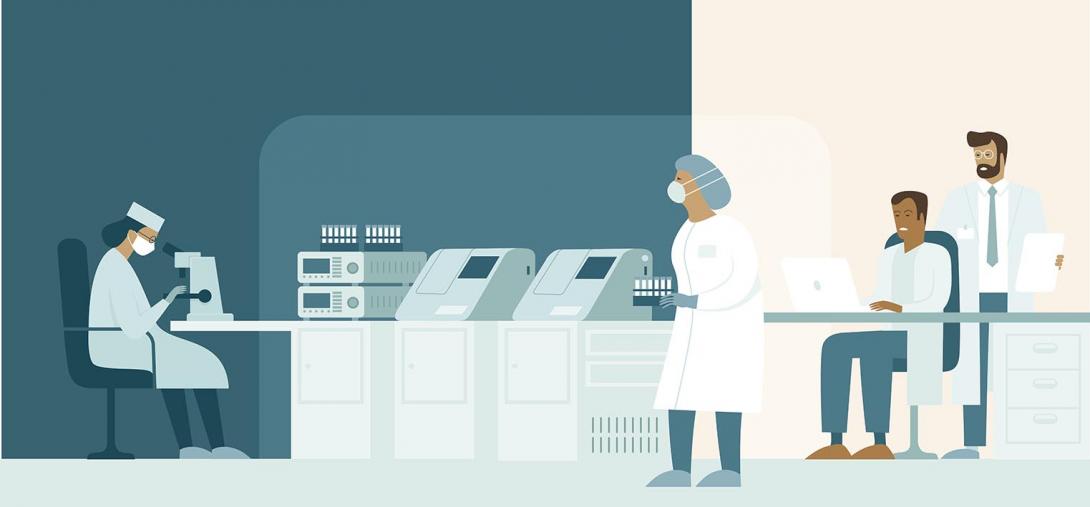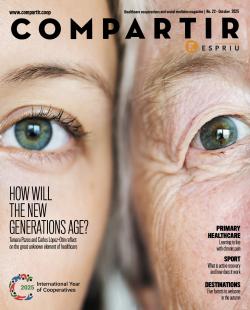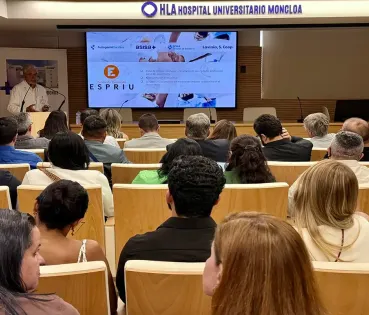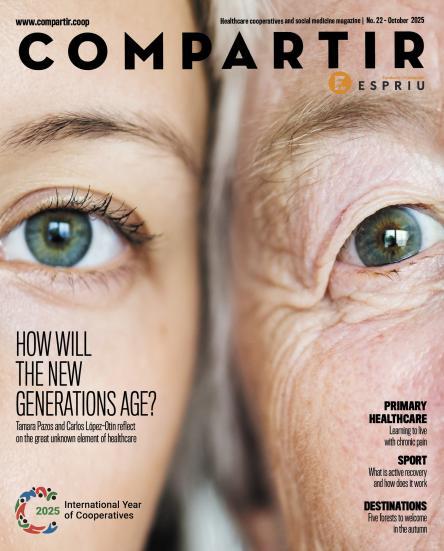
Covid-19 Diagnosis: tests and how to differentiate between them
There are several types of test to detect the virus: PCRs, antigen tests and serology are the best known ones. But, when should each test be used? How should the results be interpreted? We talk to Doctor Beatriz Candás (Laboratory of the Hospital de Barcelona) and Doctor Rodolfo Luján (Laboratory of the Hospital HLA Moncloa) to understand the differences.
Controlling the transmission of SARS-CoV-2 would not have been possible without the use of new techniques for the early diagnosis of the disease. These are the so-called Covid tests, which are divided up into two groups: the direct diagnosis techniques, which allow the microorganism or part of its structure to be detected in a sample (PCR/antigen) and the indirect diagnosis techniques, which allow the immunological response that is generated in the relation with the pathogen to be detected (serology). The figures show clearly show that without these diagnosis tests it would not have been possible to face up to the pandemic. From March, 2020 to the end of January, 2021 in Spain over 34 million tests have been carried out and over two thirds of them were PCRs. Reducing the response time for a clear, efficient and fast diagnosis is one of the greatest challenges in order to detect and stop possible outbreaks, along with improving the diagnosis tests. A goal that would be impossible without the work carried out by the laboratories and their professionals. Dr. Beatriz Candás, a Clinical Biochemistry specialist and head of the service at the clinical laboratory of the Hospital de Barcelona; and Dr. Rodolfo Luján Marca, Technical Manager of the Laboratory belonging to the Hospital Univsitario HLA Moncloa and Corporate Technical Manager at Microbiologia Analiza, have led two laboratories that have accumulated over 100,000 tests since the beginning of the pandemic. In ‘Compartir’ we have talked to them in order to understand the diagnosis tests and their differences. Each one has its limitations and not all of them can be used for each clinical situation.
How many tests are there to detect Covid-19?
Currently there are four types of diagnosis tests to detect SARS-CoV-2, the virus that causes the Covid-19 disease. “It is very important to choose each of them according to the situation to be dealt with. We could say that currently we have the following studies available: RNA detection by PCR, detection of viral antigens (Ag), detection of total antibodies (Ab) and detection of IgM or IgG antibodies,” Dr. Candás explains. Dr. Luján also points out the studies on the detection of the response of the memory T-cells (cell immunity) for immune studies. “The humoral response (antibodies) against this virus disappears some time after the onset of the infection, but the one that is based on the T-cells may remain for years.”
The PCR technique
This is the most commonly used test to detect the virus from respiratory samples. It requires professional personnel to carry it out and the waiting time for the result is around five hours. What does it consist of? The PCR is a molecular biology technique that is used in a clinical context, both in the diagnosis of infectious diseases and in the diagnosis of genetic diseases. Its function in the area of infections is to detect the presence of genetic material from microorganisms. The letters PCR correspond to Polymerase Chain Reaction,” Beatriz Candás explains.
The reliability of the PCR is virtually total, but at times it depends on the patient’s clinical history, on their surroundings and on the date of the onset of the symptoms. For this reason, Dr. Luján points out that “the PCR has its limitations. The sensitivity depends on the viral load, varying between 80% and 95%, depending on different factors – basically the quality of the sample and the moment it is taken. The samples that give the best yield are the nasopharyngeal ones.”
In simple terms, if the result is positive, the infection is confirmed, although Dr. Candás warns of the importance of the times and of the interpretation of the results: “Although in some patients the virus is detected beyond day 10, the viral load is around 100-1,000 times lower, which would suggest a low transmission capacity at this time. Additionally, from the sixth day after the onset of symptoms, the absence of infective virus has been shown. This seems to indicate that in people with slight symptoms, after the first week from the onset of symptoms the probability of transmitting the infection to others would be very low, even when the virus is still detectable by PCR, probably linked to the appearance of the immune response.”
Antigen tests
In the same way as the PCR, the antigen test seeks to detect the current presence of the virus in the patient. The technique for collecting the sample is also similar (swab) and in this case a protein that is found on the surface of the virus is sought. The advantages of this test, according to Candás, “are the speed of carrying it out, no qualified personnel are needed and it has as good diagnosis sensitivity in symptomatic patients, particularly 2-5 days from the onset of symptoms.” On the other hand, the sensitivity of this trial is not as good if it is carried out once this period of time has passed. “From this moment onwards, the sensitivity starts to decrease. In addition, in asymptomatic patients there is more controversy in the sensitivity data. It is less sensitive than the PCR, showing a higher percentage of false negatives,” Dr. Luján indicates. A positive result indicates the presence of the virus at this moment. If this causes illness, it must be compared with clinical data. Not all patients with detection of AARS-.CoV-2 genetic material will develop Covid-19.
Serology tests
Our organism produces antibodies when it has been in contact with a virus. Serology tests seek to find past infections and to do this, a blood sample needs to be obtained. But not all of them are the same, nor do they offer the same accuracy in their results. “There are tests that detect total antibodies (IgG +IgM) without differentiating between them and others that detect both types separately. The former can be carried out using capillary blood obtained from pricking a finger, but they are qualitative tests that do not quantify the amount of antibodies. If we use serum or plasma we can differentially quantify each of the immunoglobulins,” Lujan explains. Knowing exactly which antibodies we have generated and their levels is decisive for discovering the state of the disease. “To do this there are the ELISA (enzyme immunoassay) and CLIA (chemiluminescence) techniques. The CLIA test is faster and both offer greater sensitivity and specificity than the fast tests (capillary blood). The Spanish Immunology Society (SEI) informs us that once the infection has occurred, IgM antibodies can be generated in the first place (starting to rise after 5-7 days), although they usually make the laboratory tests positive after 8-14 days. The IgG start to appear after 15-21 days,” the Technical Manager of the Laboratory at the Hospital Universitario HLA Moncloa explains.
Are the so-called Fast PCRs reliable?
The only negative point of the PCR test is the time it takes to obtain a result sometimes. For this reason there are also the so-called fast or urgent PCRs, new tests that are used particularly in hospitals and with a diagnosis efficiency that is similar to the traditional PCR. “There is a test that uses very similar technology, providing very reliable results in 20-30 minutes with a very low percentage of false negatives,” Dr. Luján explains. “The preparation of the sample before processing it takes just one minute and its advantage, in addition to the speed, is its ease of use. Once the sample has been taken, it is put into the test cartridge containing the reagents and it is placed in the laboratory’s machine for 20 minutes.” This test still requires technical personnel.
The response times
The fastest of all is the antigen test, which takes between 15-20 minutes and it only offers qualitative results. Similarly, the so-called PCR Fast offers results in 20 or 30 minutes. On the other hand the conventional PCR needs around five hours. Serology or search for antibodies can also be obtained in 15 minutes for a qualitative result, when the test is on capillary blood, whilst if the CLIA test is chosen, this takes 30 minutes. In the case of ELISA, this takes over 3 hours.
The tests of the future: simpler and faster
The Covid-19 pandemic has transformed the diagnosis systems. It is predictable that in the near future new fast, reliable tests appear. “According to the evolution of the pandemic, the mutations of the virus and the need for diagnosis tests, the in vitro diagnosis industry must provide new developments, particularly regarding analysis speed and a cheapening the costs. The incorporation of ready for use procedures with lyophilised reagents, with a lower risk of exposure for the personnel are the future lines for tackling this pandemic, a great challenge for the laboratories,” the manager of the laboratory of the Hospital de Barcelona states. In the same way that the race for the vaccine speeded up the processes aimed at obtaining protection as soon as possible, the route for detecting the virus earlier and heading off any possible outbreaks is also moving forward at great speed. “There are new technological approaches and mass spectrometry systems are being developed for fast diagnosis of infection by SARS-CoV-2. With PCRs, genetic markers are detected, but with mass spectrometry viral proteins and the immune response may be detected. It is based on the idea that each gene codifies a protein. This technology detects molecules in the samples, enabling the proteins present to be identified in a question of seconds. Each protein has its specific molecular mass or weight. The equipment can highlight these specific proteins in the virus by differentiating between the different masses. Even when there are mutations in the microorganism, proteins that have not undergone any changes can be identified,” Dr. Luján explains.





